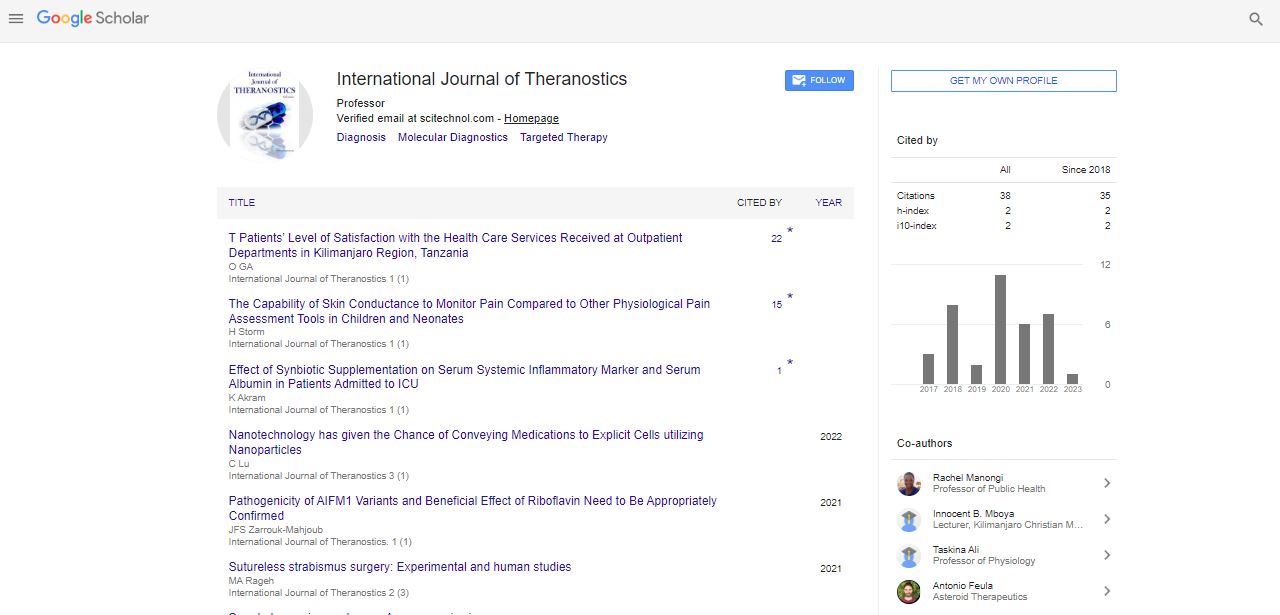Opinion Article, Int J Theranostic Vol: 12 Issue: 2
Significance of Molecular Imaging in Contemporary Medicine
Ishioh Huma*
1Nanotheranostics Research Center, Oxford University, England, UK
*Corresponding Author: Ishioh Huma,
Nanotheranostics Research Center,
Oxford University, England, UK
E-mail: Humaioh53@hotmail.com
Received date: 29 May, 2023, Manuscript No. IJT-23-106968;
Editor assigned date: 31 May, 2023, PreQC No. IJT-23-106968 (PQ);
Reviewed date: 14 June, 2023, QCNo IJT-23-106968;
Revised date: 21 June, 2023, Manuscript No. IJT-23-106968 (R);
Published date: 30 June, 2023, DOI: 10.4172/IJT.1000129.
Citation: Huma I (2023) Significance of Molecular Imaging in Contemporary Medicine. Int J Theranostic 12:2.
Description
Molecular imaging has emerged as a powerful tool in modern medicine, enabling non-invasive visualization and quantification of cellular and molecular processes in living organisms. This study provides a comprehensive review of molecular imaging, covering its principles, imaging modalities, applications, and future prospects. It explore the transformative impact of molecular imaging in various medical disciplines, from early disease detection to personalized treatment monitoring.
Molecular imaging represents a cutting-edge field at the interface of imaging sciences and molecular biology. By visualizing cellular and molecular processes in vivo, molecular imaging provides valuable insights into disease pathogenesis and facilitates personalized medicine approaches.
Principles of molecular imaging
Probes and tracers: Molecular imaging relies on the use of specific imaging probes or tracers that selectively bind to molecular targets, highlighting cellular processes of interest.
Signal detection: Different imaging modalities, such as Positron Emission Tomography (PET), Single-Photon Emission Computed Tomography (SPECT), Magnetic Resonance Imaging (MRI), ultrasound, and optical imaging, detect signals emitted by the imaging probes or tracers.
Quantitative analysis: Molecular imaging allows for quantitative analysis, enabling researchers and clinicians to measure molecular changes and disease progression.
Molecular imaging modalities
Positron Emission Tomography (PET): PET employs radiotracers labeled with positron-emitting radionuclides, allowing for highly sensitive and quantitative imaging of molecular targets.
Single-Photon Emission Computed Tomography (SPECT): SPECT utilizes gamma-emitting radiotracers to visualize molecular processes, providing 3D images with good tissue penetration.
Magnetic Resonance Imaging (MRI): MRI uses magnetic fields and radiofrequency pulses to produce high-resolution images, with the potential for molecular and functional imaging using contrast agents.
Ultrasound imaging: Ultrasound imaging offers real-time visualization of molecular targets through the use of targeted microbubbles and nanoparticles.
Optical imaging: Optical imaging employs light-emitting probes for high-resolution and sensitive imaging, especially in small animal models.
Applications of molecular imaging
Oncology: Molecular imaging plays a vital role in cancer diagnosis, staging, and treatment response assessment. PET and SPECT are commonly used to visualize tumor metabolism and receptor expression.
Cardiovascular imaging: In cardiology, molecular imaging aids in the assessment of myocardial perfusion, ischemia, and atherosclerotic plaque characterization.
Neuroimaging: Molecular imaging in neurology enables the detection of amyloid plaques in Alzheimer's disease and the study of neurotransmitter receptors.
Infectious diseases: Molecular imaging facilitates the non-invasive detection and monitoring of infectious agents and their response to antimicrobial therapy.
Advantages of molecular imaging
Early disease detection: Molecular imaging allows for the detection of cellular changes before structural alterations become evident, enabling early disease diagnosis.
Non-invasive and real-time imaging: Molecular imaging techniques are non-invasive and provide real-time visualization, reducing patient discomfort and the need for invasive procedures.
Personalized medicine: Molecular imaging contributes to personalized medicine by guiding treatment decisions based on individual molecular profiles.
Future perspectives and innovations
Multimodal imaging: The integration of multiple molecular imaging modalities will enable comprehensive disease characterization and improve diagnostic accuracy.
Nanoparticle-based imaging agents: Nanotechnology advancements offer the potential for highly sensitive and targeted molecular imaging using nanoparticle-based contrast agents.
Theranostic imaging: Combining molecular imaging with therapeutic agents will enable theranostic approaches, allowing real-time treatment monitoring and adjustment.
Challenges and limitations
Radiotracer development: The synthesis of novel imaging probes and tracers requires meticulous validation and regulatory approval.
Quantification and standardization: Ensuring standardized protocols and quantification methods across different imaging centers are important for reproducible results.
Conclusion
Molecular imaging has revolutionized medical diagnostics and research by enabling non-invasive visualization and quantification of cellular and molecular processes. As technology continues to advance, molecular imaging holds the potential to further transform patient care, supporting early disease detection, targeted treatments, and personalized medicine approaches. Collaborative efforts between scientists, clinicians, and industry partners will drive innovation in molecular imaging, ultimately leading to improved health outcomes and enhanced understanding of disease pathogenesis.
 Spanish
Spanish  Chinese
Chinese  Russian
Russian  German
German  French
French  Japanese
Japanese  Portuguese
Portuguese  Hindi
Hindi 